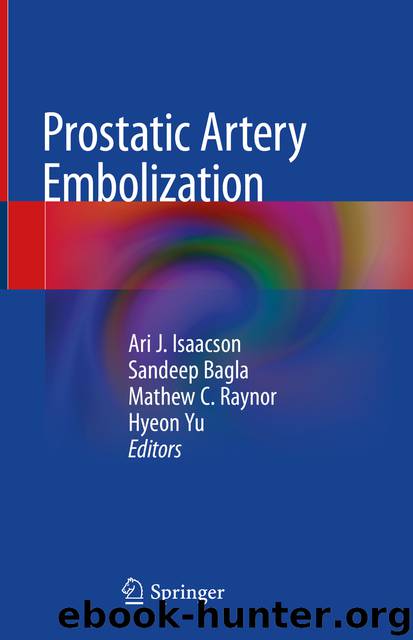Prostatic Artery Embolization by Ari J. Isaacson & Sandeep Bagla & Mathew C. Raynor & Hyeon Yu

Author:Ari J. Isaacson & Sandeep Bagla & Mathew C. Raynor & Hyeon Yu
Language: eng
Format: epub
ISBN: 9783030234713
Publisher: Springer International Publishing
Although MRI of the prostate is quite sensitive for cancer, there are limitations. The prostate cancers that are usually missed are low Gleason score cancers, organ confined cancers, cancers that are small or very small in size (<10% volume), and satellite lesions.
Recent literature outlines a classification system for different patterns of BPH on MRI [15, 16]. There are no defined treatment strategies for BPH based on these patterns, but future research on treatment outcomes with the various phenotypes may help to predict likelihood of treatment response. There are seven phenotypic types of benign prostatic hyperplasia described which are classified based on the patterns of lobar enlargement. The types are as follows: type 1, bilateral transition zone (TZ) enlargement ; type 2, retrourethral enlargement; type 3, bilateral TZ and retrourethral enlargement; type 4, solitary or multiple pedunculated; type 5, pedunculated with bilateral TZ and/or retrourethral enlargement; type 6, subtrigonal or ectopic enlargement; and type 7, other combinations of enlargements. Type 0 has also been described as a prostate showing little or no enlargement with a total prostate volume ≤25 cc. Retrourethral enlargement is analogous to median lobe hypertrophy as described in the original Randall classification from 1931 [17]. Retrourethral enlargement can cause bladder outlet obstruction by displacing the bladder trigone superiorly. Pedunculated enlargement refers to nodular enlargement from a superficial periurethral gland in the posterior wall of the proximal urethra, which then protrudes into the bladder above the urethra. With pedunculated enlargement, there is no displacement of the bladder trigone. Subtrigonal enlargement is limited to the subtrigonal region without continuity with other regions. Figure 5.5a–c shows a typical appearance of BPH on MRI.
Fig. 5.5(a–c) Transverse (a), coronal (b), and sagittal (c) T2 images of a prostate in a patient with BPH. There is a nodular enlarged transition zone (yellow arrow) with heterogenous signal throughout. The peripheral zone (white arrow) is homogenously T2 hyperintense and is compressed by the hypertrophied transition zone. In c, notice that the hypertrophied transition zone is causing mass effect on the inferior portion of the bladder (red arrow)
Download
This site does not store any files on its server. We only index and link to content provided by other sites. Please contact the content providers to delete copyright contents if any and email us, we'll remove relevant links or contents immediately.
Periodization Training for Sports by Tudor Bompa(8170)
Why We Sleep: Unlocking the Power of Sleep and Dreams by Matthew Walker(6618)
Paper Towns by Green John(5089)
The Immortal Life of Henrietta Lacks by Rebecca Skloot(4525)
The Sports Rules Book by Human Kinetics(4294)
Dynamic Alignment Through Imagery by Eric Franklin(4118)
ACSM's Complete Guide to Fitness & Health by ACSM(3989)
Kaplan MCAT Organic Chemistry Review: Created for MCAT 2015 (Kaplan Test Prep) by Kaplan(3940)
Introduction to Kinesiology by Shirl J. Hoffman(3725)
Livewired by David Eagleman(3684)
The Death of the Heart by Elizabeth Bowen(3552)
The River of Consciousness by Oliver Sacks(3540)
Alchemy and Alchemists by C. J. S. Thompson(3451)
Bad Pharma by Ben Goldacre(3356)
Descartes' Error by Antonio Damasio(3230)
The Emperor of All Maladies: A Biography of Cancer by Siddhartha Mukherjee(3066)
The Gene: An Intimate History by Siddhartha Mukherjee(3047)
The Fate of Rome: Climate, Disease, and the End of an Empire (The Princeton History of the Ancient World) by Kyle Harper(3003)
Kaplan MCAT Behavioral Sciences Review: Created for MCAT 2015 (Kaplan Test Prep) by Kaplan(2936)
